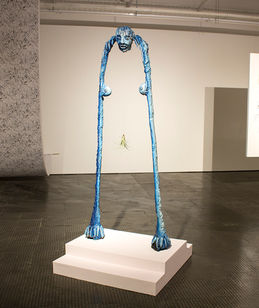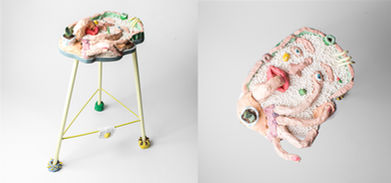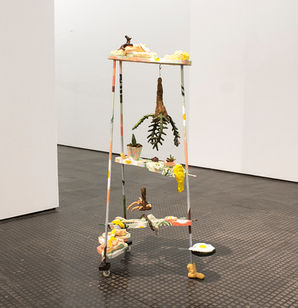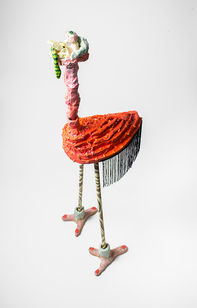MARLENE STEYN
Your Skin Is Not The Best Hiding Place
EXHIBITION TEXT
Solo Exhibition
06.08.16 – 10.09.16
Cape Town
The Corps Morcele Cookbook
Ingredients:
Space for humans, large enough for whisking
Spatulas and paint, seasoned with dis-coarse
An inchoate collection of desires
Ports for connecting, both hardware and software
A difficult and complicated psychopathology of self-definition and ego-formation
Ferns, succculants and other leafy greens
Debilitating self-revelation, to taste
High temperatures for warm feet and toes
Headphones
Mix two-parts psychoanalytic theory and add a scoop of Eastern philosophy. Blend in a good dash of contemporary artefacts and add a friendly user interface. Separate the dough and brush with egg. Insert a small and careful reference to the use of fine art materials and an implied feminist grounding, and you get a unique visual lexicon, a closed and infintely duplicating circuit of signifiers appropriated and reinvented – the hommelette-omelette world of Marlene Steyn.
-
What is skin? It is an organ, inside-out. It is absorbent, as equally to a stranger’s touch as it is to coconut oil. Our worldview is constructed based on the assumption that our skin is the final barrier between us and the world; that whatever is inside is private, and we are in control of both the cognitive and the physical in a deliberate way. Inversely, a misguided perception of control over our environment, as well as its effects on our psyche, is commonplace. Our idea of ‘self’ is conceptualised as internal and external, as mind and body, as vessel and spirit – the Cartesian dualism of the ghost-in-the-machine[1].
With Your Skin Is Not The Best Hiding Place, Marlene Steyn has disassembled the machine, painted the various components and reconfigured the workings. From the outset, the title intimates a sense of vulnerability, highlighting the fragility of the skin and suggesting a latent threat. It acts as a primer, reviewing the terminology and constructs of the traditional exhibition space. For instance, the term: “a body of work”, takes on a violent tone of separation. Steyn has constructed a generous and multiplexing[2] selfportrait, a set of ports and processes, with her own image and experience acting as the CPU. She is laying herself bare – there is nothing to hide behind. As if forgetting how to ‘be’, the artist is leaving herself instructions, reminders pinned up around the deconstructed house-of-herself. She is inviting you in, both as witness to the fragmentation as well as complicit participant in her symbolic reconstruction.
While Steyn’s work has often been compared to the paintings of Dutch Master Hieronymous Bosch, this new series of works includes allusions to other important artists. The Consequence of Waving (2016), a large painting with a reduplicating pattern of figures, features strong visual reference to Hokusai’s iconic Great Wave[3]. Here, tendrils of foam are seen consorting with fingers and strands of hair, and a pink hairdryer turns the overwhelming storm out at sea into the overwhelming storm of the modern morning routine.
Adept at choosing telling details, Steyn is continously developing the symbolic visual language that has become the cornerstone of her practice. Her distinct iconography is established by mixing these contemporary artefacts into a mythology double-boiler, testifying the importance of how painting ‘small’ things aren’t at odds with painting ‘serious’ things. Her practice deals with larger cultural forces and mythologies, making it accessible through a deeply personal lens.
Certain motifs are especially reiterated, seen both in her paintings as well as escaping the canvas as ceramic objects. For example, in Advanced Yoga for eggs (2016), the corporal associations of the fried egg are reminiscent of Kristeva’s theory of food abjection[4]. The broken and spilled eggs are indicative of uncontrolled actions, signifying a threat to the perception of the self; yet at the same time, are too cheerful to be truly threatening. It is the sunshine and the sunny-side-down. The egg finds a final resting place, melting over the cross-bar of a footstool and slipping into the Surreal.
Marlene Steyn has progressively ventured further into the medium of sculpture, her ceramic and bronze objects acting as natural continuations of her paintings. This exhibition features the debut of large scale, hand painted bronze sculptures. As her most substantial sculptures to date, these works mark an important juncture in Steyn’s practice. Deliberate decisions in the height and size of all her sculptures convey a sense of presence and physical empathy in the viewer. The aesthetic of her work continues to reflect the first unbounded products of experimentation, with an unforced and sophisticated spontaneity.
On entering the exhibition, the viewer is enveloped and guided by a swaddling textile installation, printed black on white in a pattern of Steyn’s sketches. The imagery of figures and foliage happily devouring and being devoured, are interconnected on each side to form a seamless extending landscape. The result is an uncanny, repetitive glitch, running along the tent-like shroud which acts both as an extension of her paintings and as a conduit between the individual works themselves. The soft walls of the fragmented tent subvert the traditional gallery space, camouflaging sightlines and effectively obscuring the boundaries between the public and the private.
The quieting effect of her haiku-style titles creates the impression of an assigned ‘duration’ for each painting – it is a moment, occurring with all the compressed moments leading up to and following after it. This is the essence of Marlene Steyn’s immensely layered practice; communicating, visually, what is often restricted by language. It is a completely immersive experience, offering meandering snippets of inconlcusive advice. It is a conversation, a self-portrait, an instruction manual, a cookbook and a yoga lesson – all disguised as art.
Although catalysed by the tumult and clamour of modern day life, Your Skin Is Not The Best Hiding Place conveys none of the anxiety. Instead, Steyn has calmly built a history of moments, and selves, and universes, interconnecting them to each other and to the rest of the world, until they come close to the experiencibility of a real, human life.
-
[1] Term coined by British philosopher Gilbert Ryle to describe (and subvert) René Descartes’ mind-body fallacy.
[2] In telecommunications and computer networks, multiplexing (sometimes contracted to muxing) is a method by which multiple analog or digital signals are combined into one signal over a shared medium.
[3] The Great Wave off Kanagawa, also known as The Great Wave or simply The Wave, is a woodblock print by the Japanese ukiyo-e artist Hokusai.
[4] Julia Kristeva. The Powers of Horror: An Essay on Abjection












































